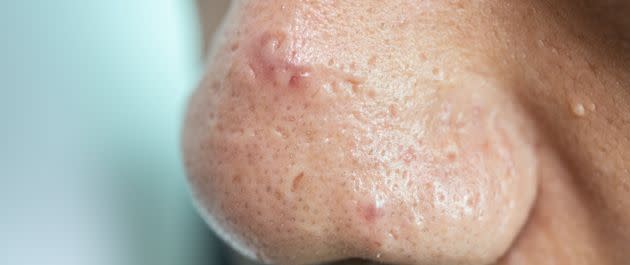Doctor Shares Red Flag Signs Your Spot Might Be Something More Serious

We’ve written before at HuffPost UK about how to differentiate an age spot from melanoma.
But what about regular-degular pimples? How can you tell those from something more serious?
In a recent TikTok, doctor and author Dr. Karan Rajan Stitched a video in which a woman showed a spot that stuck with her no matter what. It turned out to be a melanoma.
Using that video as an example, the doctor went on to share some signs “you should probably see your dermatologist.”
Which are?
Dr. Rajan explained that you should see your GP if your spot “doesn’t seem to heal or go away.”
The spot the woman showed in the video looked just like a pimple but turned out to be a basal cell carcinoma, he added ― its “typical” appearance had “rolled, curly edges.”
The most common form of skin cancer, the “spots” basal cell carcinoma may create can also sometimes have “little blood vessels or ulceration.”
The doctor went on to explain that basal cell carcinomas can even look like rashes or dry spots that don’t go away even after you apply fungal creams or emollients ― they may be misdiagnosed as ringworm or eczema.
“A skin cancer isn’t always a black or brown spot,” Dr. Rajan stressed, and it may not change rapidly. Basal cell carcinomas can take their time to grow and may match your skin colour.
What if I suspect skin cancer?
If you’re unsure, speak to your GP. “If spotted early, [basal cell carcinomas] are fairly easy to treat either through a small surgical excision or even topical treatments,” Dr. Rajan says.
HuffPost UK previously spoke to Bupa, who recommended the ABCDE method for discerning skin cancer from moles, spots, and more.
A is for asymmetry; B stands for border irregularity; C is for colour variability; D is for diameter (a mole that’s bigger than 6mm across is worth mentioning to your GP); and E stands for evolution ― moles that change in size, shape, or colour.
Ultimately, “If you notice anything unusual on your skin that doesn’t go away in a month, show it to your doctor,” The Christie NHS Foundation Trust says.
“It might help to take a photograph of anything unusual so you can check for any changes. Remember that there are many other skin conditions that are not cancer, especially in older people.”
